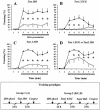Olfactory fear conditioning induces field potential potentiation in rat olfactory cortex and amygdala
- PMID: 15537739
- PMCID: PMC534705
- DOI: 10.1101/lm.83604
Olfactory fear conditioning induces field potential potentiation in rat olfactory cortex and amygdala
Abstract
The widely used Pavlovian fear-conditioning paradigms used for studying the neurobiology of learning and memory have mainly used auditory cues as conditioned stimuli (CS). The present work assessed the neural network involved in olfactory fear conditioning, using olfactory bulb stimulation-induced field potential signal (EFP) as a marker of plasticity in the olfactory pathway. Training consisted of a single training session including six pairings of an odor CS with a mild foot-shock unconditioned stimulus (US). Twenty-four hours later, the animals were tested for retention of the CS as assessed by the amount of freezing exhibited in the presence of the learned odor. Behavioral data showed that trained animals exhibited a significantly higher level of freezing in response to the CS than control animals. In the same animals, EFPs were recorded in parallel in the anterior piriform cortex (aPC), posterior piriform cortex (pPC), cortical nucleus of the amygdala (CoA), and basolateral nucleus of the amygdala (BLA) following electrical stimulation of the olfactory bulb. Specifically, EFPs recorded before (baseline) and after (during the retention test) training revealed that trained animals exhibited a lasting increase (present before and during presentation of the CS) in EFP amplitude in CoA, which is the first amygdaloid target of olfactory information. In addition, a transient increase was observed in pPC and BLA during presentation of the CS. These data indicate that the olfactory and auditory fear-conditioning neural networks have both similarities and differences, and suggest that the fear-related behaviors in each sensory system may have at least some distinct characteristics.
Figures




Similar articles
-
Basolateral amygdala activity during the retrieval of associative learning under anesthesia.Neuroscience. 2013 Mar 13;233:146-56. doi: 10.1016/j.neuroscience.2012.12.039. Epub 2013 Jan 4. Neuroscience. 2013. PMID: 23295986
-
Differential dynamics of amino acid release in the amygdala and olfactory cortex during odor fear acquisition as revealed with simultaneous high temporal resolution microdialysis.Learn Mem. 2009 Oct 28;16(11):687-97. doi: 10.1101/lm.1584209. Print 2009 Nov. Learn Mem. 2009. PMID: 19864295
-
Enduring effects of infant memories: infant odor-shock conditioning attenuates amygdala activity and adult fear conditioning.Biol Psychiatry. 2007 Nov 15;62(10):1070-9. doi: 10.1016/j.biopsych.2007.04.025. Epub 2007 Sep 10. Biol Psychiatry. 2007. PMID: 17826749
-
Long-term potentiation as a substrate for memory: evidence from studies of amygdaloid plasticity and Pavlovian fear conditioning.Hippocampus. 2002;12(5):592-9. doi: 10.1002/hipo.10099. Hippocampus. 2002. PMID: 12440575 Review.
-
Predator odor fear conditioning: current perspectives and new directions.Neurosci Biobehav Rev. 2008 Sep;32(7):1218-27. doi: 10.1016/j.neubiorev.2008.06.001. Epub 2008 Jun 5. Neurosci Biobehav Rev. 2008. PMID: 18577397 Free PMC article. Review.
Cited by
-
Olfactory learning-induced long-lasting enhancement of descending and ascending synaptic transmission to the piriform cortex.J Neurosci. 2008 Jun 25;28(26):6664-9. doi: 10.1523/JNEUROSCI.0178-08.2008. J Neurosci. 2008. PMID: 18579740 Free PMC article.
-
Background stimulus delays detection of target stimulus in a familiar odor-odor combination.Sci Rep. 2021 Jun 7;11(1):11987. doi: 10.1038/s41598-021-91295-z. Sci Rep. 2021. PMID: 34099772 Free PMC article.
-
An Evolutionarily Threat-Relevant Odor Strengthens Human Fear Memory.Front Neurosci. 2020 Apr 22;14:255. doi: 10.3389/fnins.2020.00255. eCollection 2020. Front Neurosci. 2020. PMID: 32425741 Free PMC article.
-
It's time to fear! Interval timing in odor fear conditioning in rats.Front Behav Neurosci. 2013 Sep 27;7:128. doi: 10.3389/fnbeh.2013.00128. eCollection 2013. Front Behav Neurosci. 2013. PMID: 24098277 Free PMC article.
-
Learning to smell danger: acquired associative representation of threat in the olfactory cortex.Front Behav Neurosci. 2014 Apr 7;8:98. doi: 10.3389/fnbeh.2014.00098. eCollection 2014. Front Behav Neurosci. 2014. PMID: 24778610 Free PMC article. Review.
References
-
- Baldi, E., Lorenzini, C.A., and Bucherelli, C. 2004. Footshock intensity and generalization in contextual and auditory-cued fear conditioning in the rat. Neurobiol. Learn. Mem. 81: 162-166. - PubMed
-
- Blanchard, R.J. and Blanchard, D.C. 1969. Crouching as an index of fear. J. Comp. Physiol. Psychol. 67: 370-375. - PubMed
-
- Bouret, S. and Sara, S.J. 2002. Locus coeruleus activation modulates firing rate and temporal organization of odor-induced single-cell responses in rat piriform cortex. Eur. J. Neurosci. 16: 2371-2382. - PubMed
-
- Chabaud, P., Ravel, N., Wilson, D.A., and Gervais, R. 1999. Functional coupling in rat central olfactory pathways: A coherence analysis. Neurosci. Lett. 276: 17-20. - PubMed
-
- Chabaud, P., Ravel, N., Wilson, D.A., Mouly, A.M., Vigouroux, M., Farget, V., and Gervais, R. 2000. Exposure to behaviorally relevant odor reveals differential characteristics in rat central olfactory pathways as studied through oscillatory activities. Chem. Senses 25: 561-573. - PubMed
Publication types
MeSH terms
LinkOut - more resources
Full Text Sources
